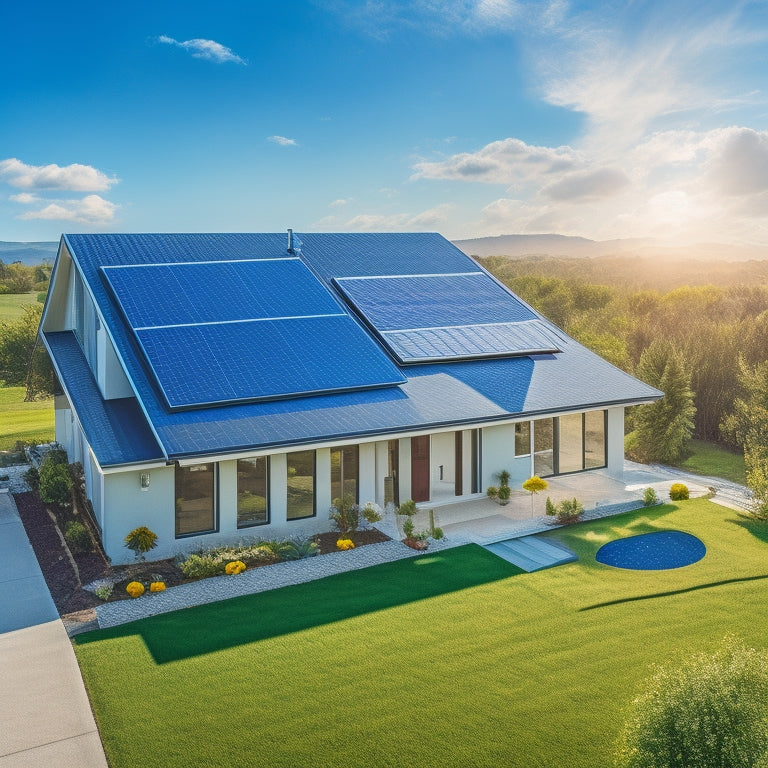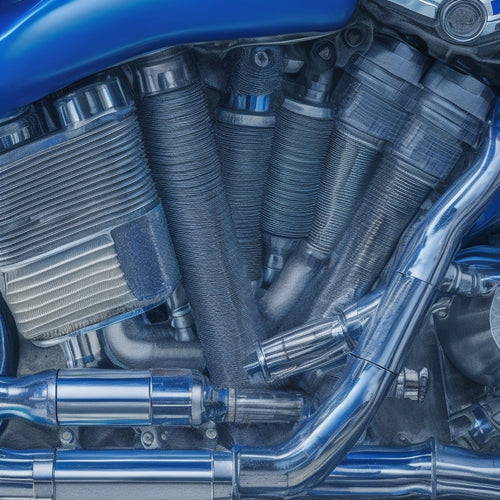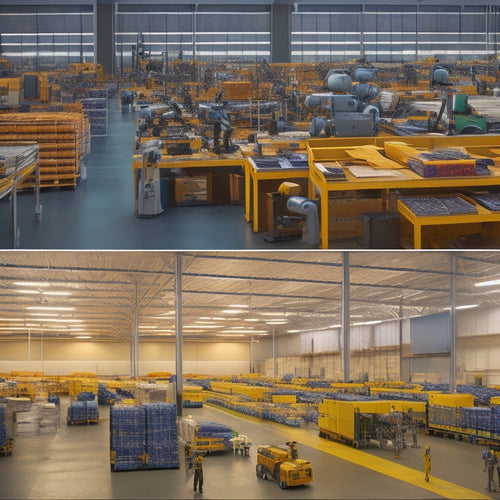
5 Best Steps to Installing Solar Panels at Home
Share
You're about to start on a journey to harness the power of solar energy at home. First, assess your home's solar potential by analyzing energy consumption patterns and ensuring your roof receives at least 4 hours of direct sunlight daily. Next, choose the right solar equipment, prioritizing high-efficiency panels and inverters. Then, prepare your roof for installation by inspecting for structural weaknesses and clearing debris. After that, install the solar panel system, meticulously connecting electrical components. Finally, connect to the grid and test the system, ensuring a safe and efficient operation. Now, take the next step towards a brighter, more sustainable future.
Key Takeaways
• Assess your home's solar potential by analyzing energy consumption patterns and checking roof orientation, slope, and shading obstructions.
• Choose the right solar equipment, including high-efficiency panels and inverters, and consider energy storage options like batteries.
• Prepare your roof for installation by inspecting for damage, clearing debris, and ensuring a structurally sound surface.
• Install the solar panel system by assembling mounting hardware, positioning panels, and connecting electrical components meticulously.
• Connect to the grid and test the system, scheduling an inspection, installing a net meter, and verifying system performance.
Assessing Your Home's Solar Potential
Determining your home's solar potential is essential to evaluate the feasibility of installing solar panels. To do this, you need to analyze your home's energy efficiency and sunlight patterns. Start by examining your energy consumption patterns to identify areas of improvement. Check your past electricity bills to determine your average daily energy usage. This will help you determine the required solar panel capacity to meet your energy needs.
Next, evaluate your home's sunlight patterns. Consider the orientation and slope of your roof, as well as any shading obstructions from trees, buildings, or other structures. Ideally, your roof should receive direct sunlight for at least four hours a day.
You can use online tools or consult with a solar expert to assess your home's solar potential. By evaluating your energy efficiency and sunlight patterns, you can determine whether investing in solar panels is a viable option for your home.
Choosing the Right Solar Equipment
With your home's solar potential assessed, you're now ready to select the right solar equipment to maximize your energy harvest, considering factors such as panel type, inverter efficiency, and mounting hardware.
When choosing solar panels, consider the type of photovoltaic cells, such as monocrystalline or polycrystalline, and their wattage output. Look for high-efficiency panels with a minimum of 20% efficiency rating. For inverters, prioritize high-efficiency models with a minimum of 95% efficiency rating to minimize energy losses. Additionally, consider the warranty options offered by manufacturers, with a minimum of 25-year warranty for panels and 10-year warranty for inverters.
If you're planning to store excess energy, research battery types such as lithium-ion or lead-acid, and consider their depth of discharge, capacity, and cycle life. It's crucial to balance your energy needs with the right equipment to ensure top performance and maximum energy harvest.
Preparing Your Roof for Installation
Before installing solar panels, you'll need to verify that your roof is structurally sound and free from obstructions, as a faulty or damaged roof can compromise the entire solar panel system. A thorough roof inspection is crucial to guarantee a successful installation.
You should inspect your roof for signs of wear, damage, or weakness, including:
-
Cracked or missing tiles: Check for any cracks, broken, or missing tiles that could jeopardize the structural integrity of your roof.
-
Sagging or uneven surfaces: Look for any signs of sagging or uneven surfaces, which could indicate a weakness in the roof's structure.
-
Overhanging branches or debris: Clear your roof of any overhanging branches, leaves, or debris that could impede the installation or damage the solar panels.
Installing the Solar Panel System
You'll need to assemble the solar panel system's mounting hardware, carefully following the manufacturer's instructions to guarantee a secure and watertight seal. Confirm the mounting system is designed for your specific roof type and can support the weight of the solar panels.
Next, position the solar panels on the mounting system, taking care to maintain the recommended spacing and orientation. System sizing is vital at this stage, as it directly affects the system's energy output. Verify that the system's capacity matches your energy requirements and local building codes.
With the solar panels in place, begin connecting the electrical components, including the inverters, charge controllers, and electrical wiring. Be meticulous when connecting the wiring, ensuring secure, waterproof connections.
A well-planned installation timeline is essential to minimize delays and ensure a smooth installation process. Allocate sufficient time for each stage, from assembling the mounting hardware to connecting the electrical components.
Connecting to the Grid and Testing
Grid connection and testing mark the final stages of your solar panel installation. This is where you'll synchronize your system with the electrical grid and verify its safe, efficient operation. This critical phase guarantees your system meets local Grid Connection Regulations and takes advantage of Net Metering Incentives.
To successfully connect to the grid, you'll need to:
-
Schedule a grid connection inspection with your utility company to confirm your system meets safety and technical standards.
-
Install a net meter to track the excess energy your system produces and feeds back into the grid. This will allow you to offset your energy consumption.
-
Perform a series of tests to verify your system's performance. These tests include voltage, current, and power output tests. They ensure your system operates within acceptable parameters.
Frequently Asked Questions
Can I Install Solar Panels on a Rented Property?
Before installing solar panels on a rented property, you'll need to obtain your landlord's permission, ensuring it's outlined in your rental contract or a separate landlord agreement, to avoid any potential disputes or complications.
Do Solar Panels Work During a Power Outage?
During a power outage, your solar panels won't provide electricity unless you have a backup system with energy storage, allowing you to harness and store excess energy generated during the day for later use.
Can I Sell Excess Energy Back to the Grid?
You can sell excess energy back to the grid through a process called net metering, earning Grid Payment credits, and engaging in Energy Trading, where you trade excess energy for future use or monetary compensation.
Are Solar Panels Affected by Weather Conditions?
As you harness the power of the sun, remember that solar panels are indeed affected by weather conditions - specifically, cloud cover reduces energy output, while temperature fluctuations impact panel efficiency, so plan accordingly.
Do Solar Panels Require Regular Maintenance?
You'll need to perform regular panel inspections to guarantee maximum energy efficiency, as dirt, debris, and faulty connections can reduce output, so schedule quarterly checks to maximize your system's performance and energy yield.
Related Posts
-

Find Your Eco-Friendly Motorcycle for a Sustainable Ride
You're shifting gears towards a more sustainable ride, opting for an eco-friendly motorcycle that combines thrill wit...
-

3 Ways to Increase Motorcycle Horsepower
You're about to unleash your motorcycle's hidden power by exploiting three key areas. First, upgrade your electric mo...
-

Why Are Online Prices for Panels So Low?
When you buy panels online, you're often taking advantage of a combination of factors that drive prices lower. You're...


